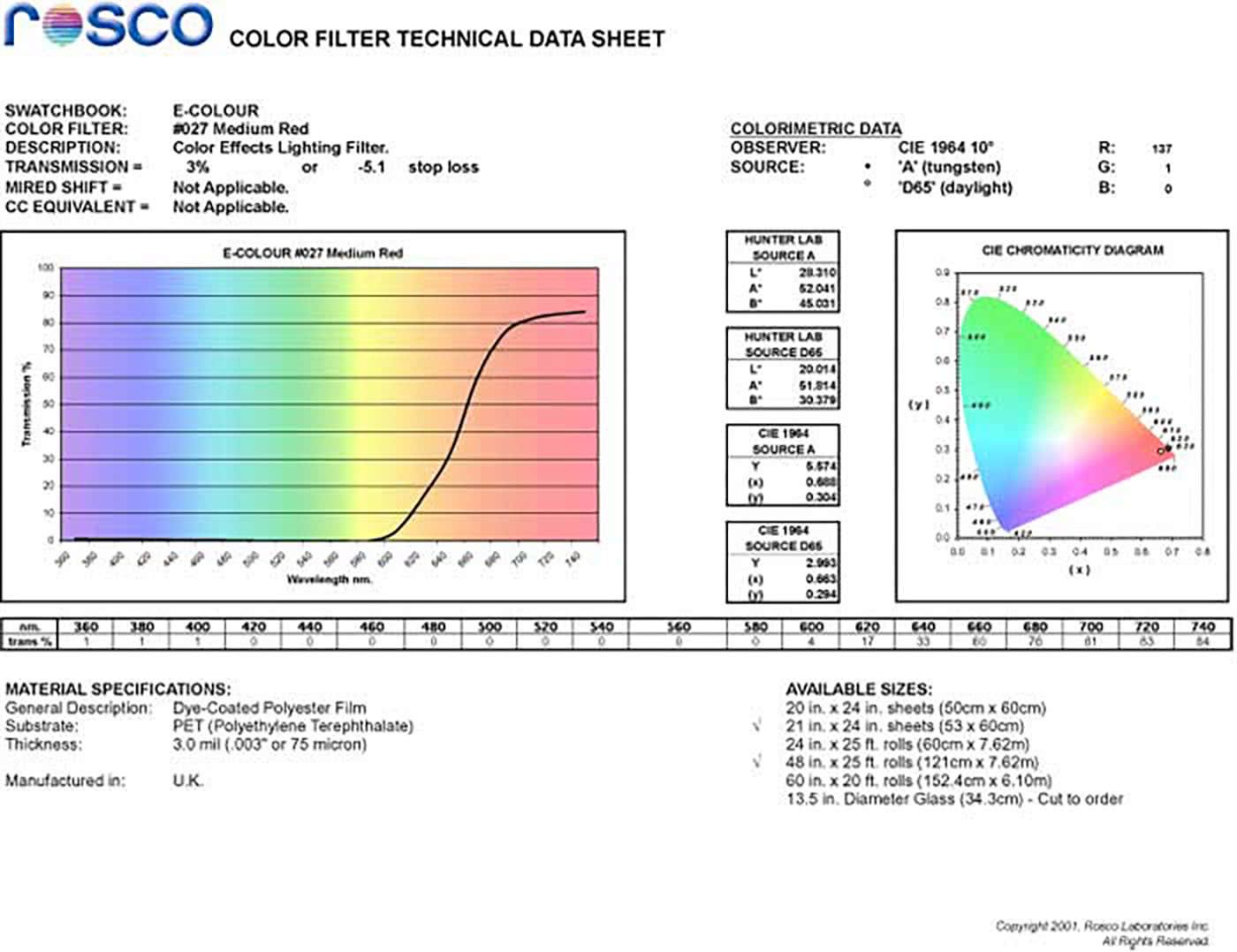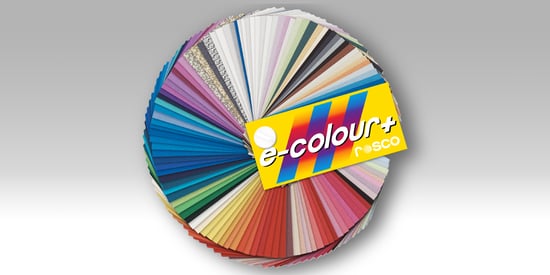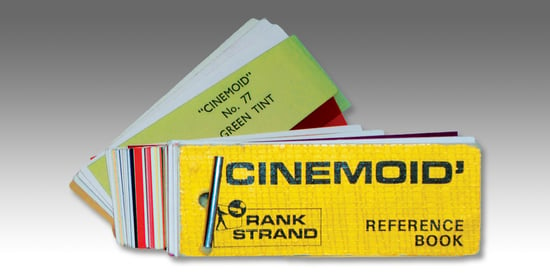E027 Rosco E Colour - Medium Red
E027 Rosco E Colour - Medium Red
e-colour+ is Rosco's comprehensive system of color filters for theatre, live-events, and film and television production. Featuring a popular European name and numbering system, e-colour+ includes a complete range of filters and materials for color correction, color effects, diffusion and reflection. They are manufactured with the latest dye formulations and bonding technology to assure the highest levels of reliability and performance.
Size:
- Sheet: 122cm x 30cm (48" x 12")
- Roll: 122cm x 7.62m (48" x 300" / 25')
- Extra-Wide Roll: 1.53m x 6.02m (60" x 20')
Share
Product Specs
Product Specs
Base:
Polyester (PET)
Gauge:
3.0 mil (.003" or 75 micron) nominal
Max Width:
48 in (1.2m)
60 in (1.5m) width available in some colors.
Click here for a full list of wide width rolls.
A select range of e-colour+ rolls feature edge marking. Click here for a full list of edge marked filter rolls.
Maximum Working Temp.:
Softening: 257°F (125° C)
Melting: 572°F (300° C)
Flame Retardant Rating:
BS3944 PART 1 1992
Compliance:
RoHS, REACH, Proposition 65
How Rosco Color Filters Work
How Rosco Color Filters Work
Filters create color by subtracting certain wavelengths of color. Thus, a red filter absorbs blue and green, allowing only the red wavelengths to pass. The process is subtractive, not additive, so the light source must emit a full spectrum.
The Rosco swatchbook provides detailed information on the spectral energy curve of each filter. The curve describes the wavelengths of color transmitted through each filter. For example, Supergel 342 transmits approximately 40% of the violet and blue energy of the spectrum and 75% of the orange and red energy. It absorbs all energy in the yellow and green range.
What is e-Colour
What is e-Colour
Rosco is the world’s largest and oldest color filter manufacturer operating today. Founded more than a century ago, it has developed numerous color filter lines over the years, including Roscolux, Cinegel, Supergel, and e-colour+. In this blog, we turn the lens onto Rosco e-colour+ to answer some of the most common questions posed by lighting professionals about this popular color filter range.
What is Rosco e-colour+?
Rosco e-colour+ is a comprehensive selection of color filters for theatre, film, and television production. It was developed in 1992 and is comprised of color correction, neutral density, color effects, diffusion, and reflection materials. e-colour+ filters are available in 21”x24” (53cm x 60cm) sheets and 48”x25’ (1.22m x 7.62m) rolls.
Is Rosco e-colour+ the same as Lee?
Yes, e-colour+ is essentially the same product as Lee. Both e-colour+ and Lee are derived from the Cinemoid filter system, which was introduced in Europe in the early 1950s by Strand Lighting. Therefore, they share the same name/number/color system. Examples:
- L201 Full CTB is the same as E201 Full CTB
- L250 ½ White Diffusion is the same as E250 ½ White Diffusion
- L210 0.6ND is the same as E210 0.6ND
- L119 Dark Blue is the same as E119 Dark Blue
Moreover, both e-colour+ and Lee filters are manufactured using the same materials and processes. They are both surface-coated polyester films (more about this below). In conclusion, there is an e-colour+ filter to match any Lee filter – just swap the L for an E!
How is Rosco e-colour+ different from Rosco Cinegel?
There are a few differences between the two filter ranges. As noted before, Cinegel and e-colour+ have different name and number systems – a three-digit system for e-colour+ and a four-digit system for Cinegel. There are color differences in their correction filters as well. A Cinegel Full CTB, for example, does not match an e-colour+ Full CTB. That's because Cinegel was originally designed in the United States to match Kodak film standards. e-colour+ filters (and Lee filters), on the other hand, match the AGFA film standards used in the UK and Europe. Although these standards are no longer as important as they once were due to the widespread use of digital cameras, they do explain why the CTO & CTB colors of Cinegel and e-colour+ differ.
Durability
Durability
The life of color filters depends on many variables: the color, the instrument and lamp used, the dimmer level a filter generally runs at, and the amount of time the light is running. For these reasons it is impossible to assign a "life" for each filter. However some basics knowledge and experience can help with estimates. Dark green and dark blue filters usually burn out the fastest because they absorb the most infrared energy. Absorbing the extra infrared energy causes the plastic to reach it's melting temperature faster. When darker filters are needed try choosing filters that transmit high amounts of the 700 nm range. You can find this information by looking at the Spectral Energy Distribution (S.E.D.) curve located in the swatchbook for each Supergel color filter. Filters than transmit high levels at 700 nm may also transmit high levels in the infrared range above 700 nm.(See the Supergel swatchbook for information on how to read S.E.D. curves.)
To prolong the life of a color filter, align your ellipsoidal lamp to a flat field focus. (Get rid of the hot spot.) You can increase the distance between the lamp and the filter by using a top hat or barn door. In extreme cases, try Rosco Heat Shield or Thermashield to prolong the life of your filters.
Never use a plastic filter directly in front of an open faced lamp. This will nearly always cause premature failure because the heat is trapped and it has nowhere to go except to the plastic filter. Always allow a suitable air gap.
Dimensions
Dimensions
- Sheets - 50cm x 122cm (24in x 21in)
- Roll - 122cm x 7.2m (48in x
- Extra-Wide Rolls - 150cm x 6m (60in)







